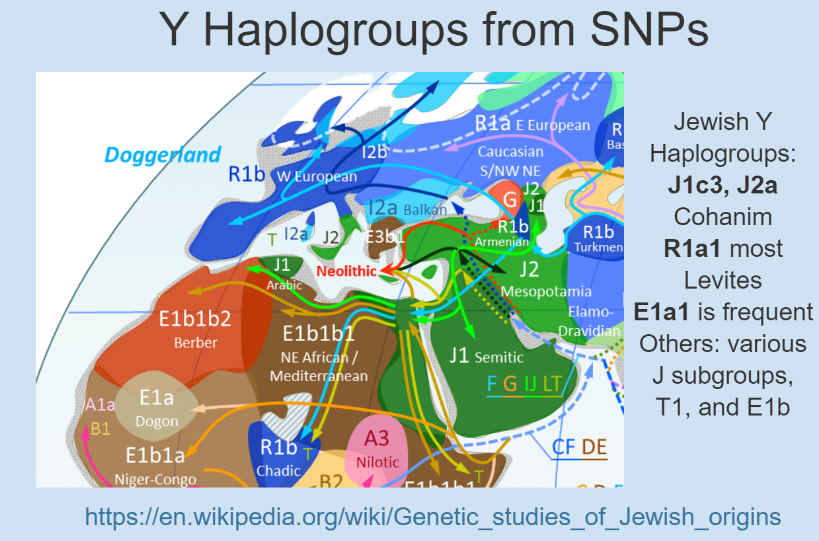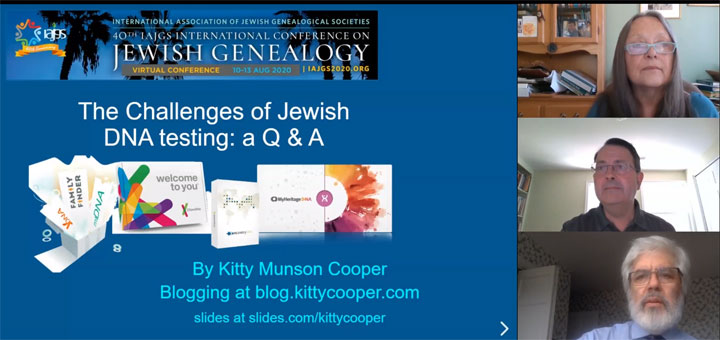The DNA results are in and they confirm that we have found the sperm donor, my late husband’s second cousin once removed. This cousin now has 8 children instead of none. Back then, donors were promised anonymity, but DNA testing has changed that; if their close family or cousins have done DNA testing, then it is likely that they can be identified. Continue reading
Archives
More on Ashkenazi DNA
It is time to update my recommendations on dealing with Ashkenazi Jewish DNA, the DNA of those who are Jewish of Northern European origin, often abbreviated AJ. The usual goals of DNA testing are to find out where your ancestors were from, to find cousins who might have good family stories, to confirm your paper genealogy, and perhaps to check on health issues. There are some special considerations for AJ DNA.
First, for Ashkenzi Jews, the ethnicity results are usually not very useful as they look like this:

Typical Ashkenazi Jewish DNA Origins as shown at Ancestry.com
Of course for some with a larger than 2% non-Jewish percentage, it can confirm a non-Jewish ancestor.
Another deep ancestry goal for the Jewish male is to confirm or look for Cohanim or Levite roots. If your Y haplogroup belongs to one of those (see below) then best to do full Y testing over at Family Tree DNA which has projects for Levites and various Cohen groups. 23andme gives you your high level haplogroup but the other testing companies do not. If you tested elsewhere, click here and scroll end of this article to learn how to get your Y haplogroup: Why Y?.

Slide on Jewish Y Haplogroups – image from a Y haplogroup crative commons image at wikipedia, no longer available
Finding relatives is difficult because all of us Ashkenazim are related multiple times, both way back when and more recently. Most AJs look like 4th or 5th cousins to each other even when that is not the case. Cousin marriages, uncle-niece marriages, and other close family marriages abound in our trees. In my own family, on my Jewish line, my great grandmother fixed up her sister with her husband’s brother to get that dowry for the family business so I have double third cousins. Click here for my article from back in 2014 that suggested that we are all descended from 350 people in the 1300s.
This means the Shared Matches feature at Ancestry is useless to us because it does not show how the two matches are related to each other and that can be quite distant [UPDATE: 26-Apr-2025: With Ancestry’s new pro tools you can see how your matches are related to each other]. Both MyHeritage and 23andme are kind enough to show how the shared matches are related to each other.
Attended My First Virtual Conference: Success!
I learned much more than usual from my first completely online conference, the 2020 IAJGS conference on Jewish Genealogy. Perhaps because there were fewer distractions: no seat-mates, no deciding on where to dine, no exhibit hall, and that I was only doing one presentation. Although it may have been because I had a purpose: to learn how to research my husband’s Polish roots. Or maybe with fewer talks, they were just very high quality ones, aside from a few technical glitches.
Actually the online format is better in many ways. I can play and replay the talks easily and take screen shots for myself of key points. There were many more questions and answers plus people could chat both privately and publicly with each other, I also really like the many excellent on demand videos on specific topics which I am still working through.
I asked my friend Heather how it went for her and she said “I especially appreciate knowing the names of the audience while listening to talks. More valuable than being there in person and perhaps only meeting the person next to me. Makes it easier to figure out who has common interests.” She also said, ” It was cool to be able to chat and make contact (share email addresses) while the talk was going on without bothering the speaker or my seat-mates.”
So what went badly? I personally never figured out the exhibit hall replacement. I missed the excitement of the live hall and seeing what was new from the various vendors. I would have loved a few small zoom-style break-out sessions on common interests where I could see everyone’s faces while chatting. However, much to my surprise, I actually preferred being at a virtual conference.
Now for a little follow up on our Chat with the Jewish DNA Experts session.
Continue reading
